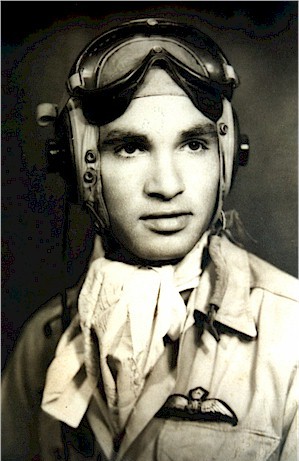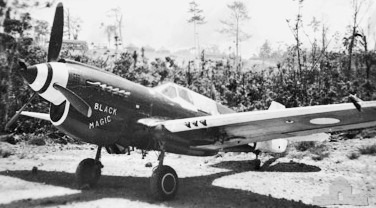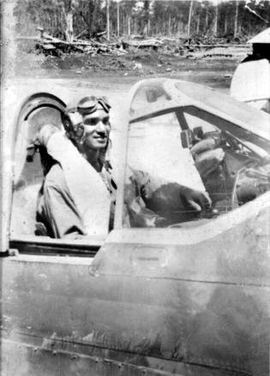Len Waters facts for kids
Quick facts for kids
Leonard Victor (Len) Waters
|
|
|---|---|

Len Waters, c. 1944–45
|
|
| Born | 20 June 1924 Boomi, New South Wales |
| Died | 24 August 1993 (aged 69) Cunnamulla, Queensland |
| Allegiance | Australia |
| Service/ |
Royal Australian Air Force |
| Years of service | 1942–46 |
| Rank | Warrant Officer |
| Unit | No. 78 Squadron |
| Battles/wars | World War II |
| Other work | Shearer |
Leonard Victor (Len) Waters (born 20 June 1924 – died 24 August 1993) was a very important person in Australian history. He was the first Aboriginal Australian to become a military pilot. He was also the only Aboriginal fighter pilot in the Royal Australian Air Force (RAAF) during World War II.
Back then, Aboriginal people faced many challenges in Australia. They had fewer rights and opportunities. Len Waters was born in New South Wales and grew up in Queensland. He worked as a shearer before joining the RAAF in 1942. He first trained as a mechanic. But he really wanted to fly planes! He became a pilot in 1944.
Len flew P-40 Kittyhawk planes in the South West Pacific. He completed 95 missions, mostly helping soldiers on the ground. By the end of the war, he was a warrant officer. After the war, he tried to start his own airline. But he couldn't get the money or permission. So, he went back to shearing sheep. Len Waters passed away in 1993 when he was 69 years old.
Contents
Early Life and Dreams
Len Waters was the fourth of 11 children. He was born at Euraba Mission, near Boomi, in New South Wales. This was on June 20, 1924. He spent his childhood in Nindigully, Queensland. He went to school until seventh grade.
From a young age, Len loved airplanes. He heard stories about famous pilots like Charles Kingsford Smith and Amy Johnson. He also read exciting adventure stories about characters like Biggles. He said he had his "head in the clouds" from early on. When he was 14, Len left school to help his family. He worked with his father, earning very little money. In 1939, he started working as a shearer.
Joining the RAAF
At first, it was hard for Aboriginal people to join the military. But when Japan entered World War II, Australia was directly attacked. So, the rules changed. Len Waters volunteered for the Royal Australian Air Force (RAAF) on August 24, 1942. He joined in Brisbane.
He started training to fix aircraft. But he really wanted to fly! He volunteered for flying duty. In December 1943, he began his pilot training. The person who interviewed him thought he looked "a bit rough." But they also said he "should make a fighter pilot." Len worried his lack of education would be a problem. So, he studied hard every night.
Len was very keen to be a pilot. He was good at Morse code, so he worried he might become a radio operator. He was even asked to imagine being a gunner in a big bomber plane. He said he looked "very disappointed" at that idea! Len was so sure he wouldn't become a pilot that he made three bets against himself. He ended up losing £15 when he was chosen!
Becoming a Fighter Pilot
Len learned to fly at No. 1 Elementary Flying Training School. He flew De Havilland Tiger Moth planes there. He then trained on CAC Wirraway aircraft. He earned his pilot's "wings" at No. 5 Service Flying Training School. He became a sergeant pilot.
Next, he went to No. 2 Operational Training Unit. Here, he learned to fly P-40 Kittyhawk fighter planes. Once, while on leave, Len faced unfair treatment. He was held by police in Moree for not carrying an identity card. This was because of unfair rules that affected Aboriginal people at the time.
On November 14, 1944, Len joined No. 78 Squadron. This fighter unit was based on Noemfoor island. When he arrived, he was given a P-40 Kittyhawk. By chance, the plane already had the name "Black Magic" painted on its nose. Len thought this was funny and kept the name.
By this time in the war, there were few Japanese planes left in the South West Pacific. So, No. 78 Squadron mostly attacked enemy positions on the ground. Len flew 95 missions. He flew from Noemfoor, and later from Morotai and Tarakan in Borneo.
During one mission, a 37 mm cannon shell hit his plane. It got stuck behind him in the cockpit but didn't explode. He flew for two more hours, knowing the shell could explode at any moment. He said it was like having a loaded gun to his head. When he landed safely, he said it was "the best landing I ever made."
On January 1, 1945, he was promoted to flight sergeant. By the end of the war, Len was leading operations. Even officers worked under his command. A friend described him as a "humble" person despite his brave actions. Besides flying, Len also held the RAAF middleweight boxing title.
Len's brother, Donald Edward (Jimmy) Waters, was a soldier in the Australian Army. After the war ended in September 1945, Len thought about joining the forces in Japan. But his brother decided not to go. So, Len returned to Australia. He left the Air Force as a warrant officer on January 18, 1946.
Life After the War
After the war, Len Waters tried to start an airline. It would have served South West Queensland. But he couldn't get the money or permission from the government. He wrote letters asking for approval, but he never got a reply. He never flew a plane again after the war.
Even though racism was less common in the military during the war, it was still a problem in everyday life. Len and other Aboriginal people who served found that their skills were not valued. He later wrote that after taking off his uniform, he simply "returned to being a blackfellow."
Four weeks after leaving the Air Force, Len married Gladys Saunders. They had six children together. He worked as a car mechanic for a short time. But he had to stop because of union rules. These rules said he needed to do an apprenticeship first. Then, he worked for a local council building roads. After that, he went back to shearing sheep. This job took him away from his family often. He sheared sheep all over Australia. He believed he sheared about a million sheep in his life!
Len applied for a house from the housing commission. He was given a house in Inala, Brisbane, in August 1956. He later bought the house and lived there for 33 years. Len Waters passed away on August 24, 1993, in Cunnamulla. He was 69 years old. He was buried in St George Cemetery.
Len Waters' Legacy
Len Waters has been remembered in many ways since his death.
- In 1995–96, Australia Post put his picture on a stamp. They also showed his "Black Magic" Kittyhawk on an aérogramme.
- A type of port was named after his plane.
- Len Waters Place, a park in Inala, was opened.
- Moree Plains Shire Council named Leonard Waters Park in Boggabilla, New South Wales.
- Len Waters Street in Ngunnawal, Australian Capital Territory, was named after him.
- In 2003, Balonne Shire Council put up a monument to Len Waters in St George.
- A new suburb called Len Waters Estate was created in New South Wales in 2009.
- In 2011, Sutherland Shire Council opened Len Waters Park in Barden Ridge. It has a special plaque.
- In October 2020, a new building at RAAF Base Williamtown was named in his honour.
- In 2018, Peter Rees wrote a book about Len Waters called Missing Man.



